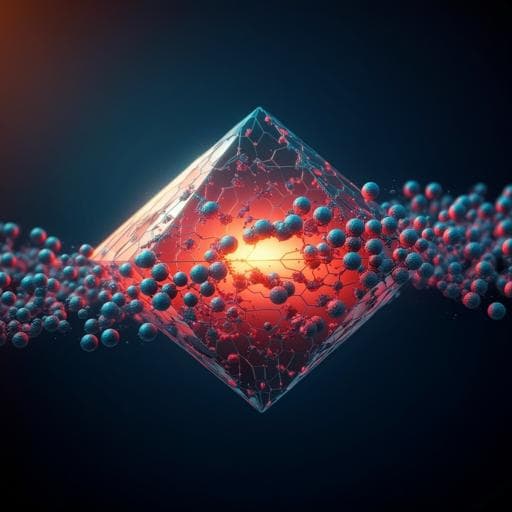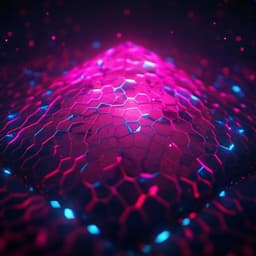
Medicine and Health
Quantum sensing of microRNAs with nitrogen-vacancy centers in diamond
J. Zalieckas, M. M. Greve, et al.
Exciting advancements in early cancer diagnostics are here! Researchers, including Justas Zalieckas and Martin M. Greve, have leveraged nitrogen-vacancy centers in diamond to detect microRNAs by measuring magnetic noise from paramagnetic counter ions. Their findings reveal how miRNA interaction increases Mn²⁺ concentration, paving the way for groundbreaking quantum biosensing technologies.
~3 min • Beginner • English
Introduction
The study addresses the challenge of label-free detection of biomolecules, particularly microRNAs (miRNAs), for early disease diagnostics. Conventional electronic biosensors that detect intrinsic molecular charge are limited by Debye screening in physiological conditions, where the Debye length is <1 nm, severely reducing sensitivity to charges beyond this distance. The authors propose overcoming this limitation by sensing magnetic noise from paramagnetic counterions (e.g., Mn2+) associated with negatively charged nucleic acids, rather than sensing the charges directly. Nitrogen-vacancy (NV) centers in diamond, with high sensitivity to magnetic noise via T1 (spin-lattice) relaxometry, are used as quantum sensors to detect microRNA-21 (miR-21), an oncogenic biomarker implicated in multiple cancers. The central hypothesis is that adsorption of miR-21 to an oxygenated, negatively charged diamond surface, mediated by Mn2+ counterions, increases local paramagnetic ion concentration near shallow NV centers and thus enhances NV relaxation, enabling sensitive, label-free detection beyond Debye screening limits.
Literature Review
- Field-effect biosensors can detect biomolecular charges but are constrained by Debye screening, which limits sensitivity under physiological ionic strengths.
- NV centers in diamond have been employed for sensing electric and magnetic fields and for nanoscale NMR/ESR, including studies of proteins, DNA labeled with nitroxide radicals, SARS-CoV-2 detection, and ultrasensitive nanodiamond-based biosensing, highlighting their versatility and sensitivity for biomedical applications.
- MicroRNAs (~20–22 nt) are clinically relevant biomarkers for cancers, neurodegenerative and autoimmune diseases. Conventional detection (Northern blotting, RT-qPCR, microarrays) requires labels, amplification, and specialized equipment, motivating label-free alternatives.
- Divalent cations (e.g., Mg2+, Ni2+, Co2+, Zn2+) are known to mediate adsorption of nucleic acids to negatively charged surfaces (e.g., mica) without compromising nucleic acid integrity; by analogy, Mn2+ is expected to associate strongly with nucleic acids and oxygenated diamond surfaces, potentially enhancing local magnetic noise for NV relaxometry.
Methodology
Experimental:
- Quantum sensing principle: Measure NV-center longitudinal spin-lattice relaxation (T1) to detect fluctuating magnetic fields generated by paramagnetic Mn2+ counterions near the diamond surface. The NV relaxation rate Γ1=1/T1 increases with the variance of the transverse magnetic field ⟨B2⟩ at the NV frequency component; contributions depend on Mn2+ spin dynamics with autocorrelation time τc.
- Diamond sample: Electronic grade single-crystal diamond ({100}), shallow NV layer at 7±3 nm depth (N implantation: 4 keV, 1013 cm−2; annealed 800 °C). Surface oxygenation via Piranha solution to form C–OH, C=O, epoxy, ether, and COOH groups.
- Microfluidics and optics: Diamond mounted in a PDMS microfluidic channel (~12 mm3), one-in/one-out. Wide-field microscope with 532 nm CW laser excitation (9 kW cm−2), no external magnetic field, ensemble NV readout via APD. Pulse sequence: 5 μs laser for initialization/readout; measure fluorescence at two interrogation times t1=10 μs and t2=400 μs; spin contrast computed from ratio of signals at t1 and t2. Typically N=20,000 repetitions per point; for sensitivity tests N=40,000. Temperature correction applied to contrast with coefficient Δ=0.0012 °C−1 to normalize to 25 °C.
- Solution protocol (flows via Elveflow controller):
• I: 1 mM EDTA (pH 2.0) at 150 μL min−1 to neutralize surface and chelate residual paramagnetic ions.
• II: 5 mM MnCl2 + 10 mM NaCl at 150 μL min−1 to adsorb Mn2+ on surface and establish baseline magnetic noise.
• III: 1 μM miR-21 in 5 mM MnCl2 + 10 mM NaCl at 50 μL min−1 to introduce target; monitor contrast increase.
• IV: Either 1 mM EDTA (to chelate/remove Mn2+ and reset) or repeat of solution II (to assess desorption of weakly bound miR-21).
- Sensitivity measurements: Sequential injections of (I) 5 mM MnCl2 + 10 mM NaCl and (II) miR-21 at concentrations 10 pM to 10 nM (in same stock), with prior flushing by Tris-EDTA buffer (pH 8.0) for 1 h.
- Controls and confounders: Verified negligible effects from NV charge conversion (sub-saturation excitation, oxygenated surface), diamagnetic electrolyte (10 mM NaCl), and electric noise from adsorbed miR-21 without Mn2+ (no contrast change between 10 mM NaCl and 1 μM miR-21 in 10 mM NaCl). Temperature fluctuations (~1.5 °C) corrected.
- Surface characterization:
• XPS (Al Kα, 45° take-off): Quantified functional groups on oxygenated surface: 64.5% C–OH/epoxy, 20.2% C=O, 13.7% O–C–O, 1.6% COOH; detected Si contamination (carbides) likely from bulk CVD growth; post-miR-21 treatment, observed P 2p (phosphate) and Mn 2p peaks.
• pH titration: Inject 5 mM MnCl2 at pH 5.3→4.0→3.0→2.0; monitored contrast decrease to water-like level at pH 2.0 indicating Mn desorption and surface neutralization (COOH protonated), confirming COOH presence.
• AFM (tapping mode, diamond-coated tip): Imaged surface before/after miR-21 exposure (1 μM miR-21 in 5 mM MnCl2 + 10 mM NaCl, 5 min). 2D FFT analysis showed increased halo diameter (higher spatial frequencies) after miR-21 indicating granular adsorbates. Scraping in contact mode (≈230 nN) removed ~0.5 nm layer, consistent with a monolayer of single-stranded miR-21.
Computational:
- All-atom MD using GROMACS with AMBER ff14SB-bsc1 (miR-21), TIP3P water, Joung–Cheatham monovalent ions, Li–Merz parameters for Mn2+. Diamond surface parameters derived from DFT; surfaces functionalized per XPS proportions (sets with either hydroxyl or epoxy plus carbonyl, ether, and variable COOH protonation).
- System: 10×10×20 nm3 water-filled box between two functionalized diamond slabs (periodic along z with 40 nm cell and vacuum buffer). Bulk ion conditions matched experiments: [MnCl2]=5 mM, [NaCl]=10 mM; additional cations for neutrality and surface charge models. Six surface models (neutral/charged; hydroxyl/epoxy sets). 48-replica REMD (298–337 K) per system for 200 ns after 1 ns equilibration; adsorption events tracked; final 1 ns NVT per replica (no exchange) for density and magnetic noise analysis.
- Magnetic noise estimation: Computed ⟨B2⟩ at an NV 7 nm below the surface by summing dipolar fields from Mn2+ ions over trajectories and averaging over spin states; quantified as a function of miR-21 distance to the surface; extrapolated to full surface coverage to estimate Δ⟨B2⟩ and related ΔΓ1 using assumed τc range (10 ps–1 ns).
Key Findings
- NV T1 relaxometry detects miR-21 via Mn2+-mediated adsorption:
• Introducing 5 mM MnCl2 + 10 mM NaCl increased spin contrast by ≈1.3% (to ~1.04) relative to EDTA-treated baseline due to Mn2+ adsorption.
• Adding 1 μM miR-21 (in same Mn/Na stock) produced an additional ≈1.0% increase (to ~1.05) in contrast, corresponding to an enhanced NV relaxation rate ΔΓ1 ≈ 1.5 kHz, attributed to excess Mn2+ accumulation near NVs mediated by adsorbed miR-21.
• Replacing EDTA with Mn/Na rinse after miR-21 led to only a slight contrast decrease, indicating most miR-21 remained adsorbed, forming a uniform layer within NV sensing range (≈20–30 nm).
- Sensitivity and limit of detection (LOD): Linear response down to 1 nM; for 10 nM, contrast rose rapidly then approached saturation after ~4200 s. No change for control without miR-21. LOD determined at 10 pM (signal >3σ over control); in a ~12 mm3 channel this corresponds to ~120 attomoles of target.
- Controls: Without Mn2+, no measurable contrast difference between 10 mM NaCl and 1 μM miR-21 in 10 mM NaCl, indicating negligible electric-noise contribution from adsorbates under these conditions. Effects from NV charge conversion and diamagnetic electrolyte were negligible.
- Surface chemistry: XPS C 1s peak deconvolution indicated oxygenated surface composition: 64.5% C–OH/epoxy, 20.2% C=O, 13.7% O–C–O, 1.6% COOH. Lowering pH of 5 mM MnCl2 to 2.0 reduced contrast to water-like levels, consistent with Mn2+ desorption and neutral surface (COOH protonated), confirming COOH presence but minor coverage.
- AFM/XPS confirmation of adsorption: Post-miR-21 imaging showed increased granularity by 2D FFT halo broadening; scraping removed ~0.5 nm layer consistent with a single miR-21 layer. XPS detected P 2p (from phosphate) and Mn 2p after treatment, confirming miR-21 and Mn presence on the surface.
- MD simulations: miR-21 adsorption occurred robustly (≈80% of replicas for neutral surfaces; ≈40–50% for charged surfaces) and remained stable once adsorbed. Adsorption induced accumulation of Mn2+ near the surface, with each adsorbed miR-21 recruiting on average ~8–9 Mn2+ within ~4 nm of the surface, largely independent of surface charge/composition. Calculated magnetic-noise enhancement for full coverage was Δ⟨B2⟩ ~ 10−10 T2, yielding an estimated ΔΓ1 between ~2.3 and 23 kHz for τc in 10 ps–1 ns, consistent in order of magnitude with the measured ~1.5 kHz.
- Sensitivity estimate from MD: Given ~180 Mn adsorbates required per diffraction-limited spot to yield a sizable signal and ~8 Mn per miR-21, the sensing modality approaches detection of ~23 miR-21 molecules.
Discussion
The results validate the hypothesis that sensing magnetic noise from paramagnetic counterions can overcome Debye screening limitations inherent to electronic charge-based biosensing of nucleic acids. Experimentally, miR-21 presence increases NV relaxation via Mn2+-mediated adsorption to an oxygenated diamond surface, with confirmatory AFM and XPS evidence of miR-21 and Mn on the surface. The method achieves a 10 pM LOD (≈120 attomoles in the tested microfluidic volume), demonstrating practical sensitivity for label-free miRNA detection. MD simulations corroborate the mechanism: adsorption of miR-21 recruits additional Mn2+ near the surface, enhancing local magnetic noise at NV depths, and predicted noise/relaxation changes are consistent with measured kHz-scale ΔΓ1. This approach directly targets the ionic atmosphere around polyanionic targets, rather than their screened charges, and should generalize to other polyelectrolytes. The findings suggest potential integration with microarray technologies to eliminate fluorescent labeling, and highlight pathways to improve sensitivity further (optimized pulse sequences, shallower NVs).
Conclusion
This work demonstrates label-free detection of microRNA-21 using NV-center T1 relaxometry by sensing magnetic noise from paramagnetic Mn2+ counterions associated with the nucleic acid near a functionalized diamond surface. Experiments show kHz-scale enhancement in NV relaxation and a 10 pM limit of detection, while AFM and XPS confirm miR-21 adsorption and Mn mediation. MD simulations elucidate the adsorption mechanism and quantify Mn2+ accumulation and resultant magnetic-noise increases consistent with the observed signals. The approach circumvents Debye screening and is broadly applicable to polyelectrolyte sensing, with potential translation to microarray platforms and operation in non-transparent media. Future work should focus on enhancing sensitivity via noise-cancelling pulse sequences, engineering NVs closer to the surface, refining models of spin dynamics (τc), and expanding to diverse targets and complex biofluids.
Limitations
- The estimate of the Mn2+ spin autocorrelation time τc for ions bound to RNA is not independently measured; the conversion from magnetic-noise variance to ΔΓ1 relies on assumed τc (10 ps–1 ns), yielding only order-of-magnitude agreement.
- The study is a proof-of-principle with a simplified surface/ionic environment; surface chemistry heterogeneity and NV depth distributions may affect quantitative predictions.
- Temperature fluctuations influence T1; measurements required post hoc temperature corrections and residual variability remained.
- XPS indicated silicon contamination likely in the bulk; assessed as minimal for interactions considered but not fully eliminated.
- Detection relies on adding paramagnetic counterions (Mn2+); performance without such ions or in complex biological matrices was not evaluated here.
- The pH- and composition-dependent adsorption and potential oligonucleotide aggregation at higher Mn2+:phosphate ratios may impact dynamic range and kinetics.
Related Publications
Explore these studies to deepen your understanding of the subject.







